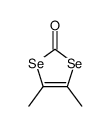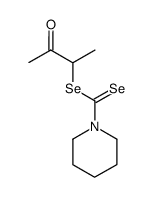1,3-Diselenole,2-(4,5-dimethyl-1,3-diselenol-2-ylidene)-4,5-dimethyl-
Modify Date: 2024-01-04 20:19:31

1,3-Diselenole,2-(4,5-dimethyl-1,3-diselenol-2-ylidene)-4,5-dimethyl- structure
|
Common Name | 1,3-Diselenole,2-(4,5-dimethyl-1,3-diselenol-2-ylidene)-4,5-dimethyl- | ||
|---|---|---|---|---|
| CAS Number | 55259-49-9 | Molecular Weight | 448.04200 | |
| Density | N/A | Boiling Point | 338.8ºC at 760 mmHg | |
| Molecular Formula | C10H12Se4 | Melting Point | 273-275ºC (dec.)(lit.) | |
| MSDS | Chinese USA | Flash Point | 158.7ºC | |
| Symbol |



GHS06, GHS08, GHS09 |
Signal Word | Danger | |
| Name | Tetramethyltetraselenafulvalene |
|---|---|
| Synonym | More Synonyms |
| Boiling Point | 338.8ºC at 760 mmHg |
|---|---|
| Melting Point | 273-275ºC (dec.)(lit.) |
| Molecular Formula | C10H12Se4 |
| Molecular Weight | 448.04200 |
| Flash Point | 158.7ºC |
| Exact Mass | 451.76000 |
| LogP | 1.45980 |
| Appearance of Characters | solid |
| Storage condition | 2-8°C |
Synonym: Section 2 - COMPOSITION, INFORMATION ON INGREDIENTS
Risk Phrases: 23/25 33 Section 3 - HAZARDS IDENTIFICATION EMERGENCY OVERVIEW
Toxic by inhalation and if swallowed. Danger of cumulative effects. Potential Health Effects Eye: May cause eye irritation. Skin: May cause skin irritation. Ingestion: Poison by ingestion. Inhalation: Toxic if inhaled. Chronic: Not available. Section 4 - FIRST AID MEASURES Eyes: Flush eyes with plenty of water for at least 15 minutes, occasionally lifting the upper and lower eyelids. Get medical aid. Skin: Get medical aid. Flush skin with plenty of water for at least 15 minutes while removing contaminated clothing and shoes. Ingestion: Get medical aid immediately. Wash mouth out with water. Inhalation: Get medical aid immediately. Remove from exposure and move to fresh air immediately. If not breathing, give artificial respiration. If breathing is difficult, give oxygen. Notes to Physician: Section 5 - FIRE FIGHTING MEASURES General Information: As in any fire, wear a self-contained breathing apparatus in pressure-demand, MSHA/NIOSH (approved or equivalent), and full protective gear. Extinguishing Media: Use water spray, dry chemical, carbon dioxide, or chemical foam. Section 6 - ACCIDENTAL RELEASE MEASURES General Information: Use proper personal protective equipment as indicated in Section 8. Spills/Leaks: Vacuum or sweep up material and place into a suitable disposal container. Section 7 - HANDLING and STORAGE Handling: Do not breathe dust, vapor, mist, or gas. Do not get in eyes, on skin, or on clothing. Use only in a chemical fume hood. Storage: Store in a cool, dry place. Store in a tightly closed container. Store under nitrogen. Section 8 - EXPOSURE CONTROLS, PERSONAL PROTECTION Engineering Controls: Facilities storing or utilizing this material should be equipped with an eyewash facility and a safety shower. Use adequate ventilation to keep airborne concentrations low. Exposure Limits CAS# 55259-49-9: Personal Protective Equipment Eyes: Not available. Skin: Wear appropriate protective gloves to prevent skin exposure. Clothing: Wear a chemical apron. Respirators: A NIOSH/MSHA approved air purifying dust or mist respirator or European Standard EN 149. Section 9 - PHYSICAL AND CHEMICAL PROPERTIES Physical State: Solid Color: Not available. Odor: Not available. pH: Not available. Vapor Pressure: Not available. Viscosity: Not available. Boiling Point: Not available. Freezing/Melting Point: 265 - 270 deg C (de Autoignition Temperature: Not available. Flash Point: Not available. Explosion Limits, lower: Not available. Explosion Limits, upper: Not available. Decomposition Temperature: Solubility in water: Specific Gravity/Density: Molecular Formula: C10H12Se4 Molecular Weight: 447.924 Section 10 - STABILITY AND REACTIVITY Chemical Stability: Stable under normal temperatures and pressures. Conditions to Avoid: Incompatible materials. Incompatibilities with Other Materials: Strong oxidizing agents. Hazardous Decomposition Products: Carbon monoxide, carbon dioxide, selenium/selenium oxides. Hazardous Polymerization: Has not been reported Section 11 - TOXICOLOGICAL INFORMATION RTECS#: CAS# 55259-49-9 unlisted. LD50/LC50: Not available. Carcinogenicity: Tetramethyltetraselenafulvalene - Not listed by ACGIH, IARC, or NTP. Section 12 - ECOLOGICAL INFORMATION Section 13 - DISPOSAL CONSIDERATIONS Dispose of in a manner consistent with federal, state, and local regulations. Section 14 - TRANSPORT INFORMATION IATA No information available. IMO No information available. RID/ADR No information available. Section 15 - REGULATORY INFORMATION European/International Regulations European Labeling in Accordance with EC Directives Hazard Symbols: T Risk Phrases: R 23/25 Toxic by inhalation and if swallowed. R 33 Danger of cumulative effects. Safety Phrases: S 20/21 When using do not eat, drink or smoke. S 28A After contact with skin, wash immediately with plenty of water. S 45 In case of accident or if you feel unwell, seek medical advice immediately (show the label where possible). WGK (Water Danger/Protection) CAS# 55259-49-9: No information available. Canada None of the chemicals in this product are listed on the DSL/NDSL list. CAS# 55259-49-9 is not listed on Canada's Ingredient Disclosure List. US FEDERAL TSCA CAS# 55259-49-9 is not listed on the TSCA inventory. It is for research and development use only. SECTION 16 - ADDITIONAL INFORMATION N/A |
| Symbol |



GHS06, GHS08, GHS09 |
|---|---|
| Signal Word | Danger |
| Hazard Statements | H301 + H331-H373-H410 |
| Precautionary Statements | P261-P273-P301 + P310-P311-P501 |
| Personal Protective Equipment | dust mask type N95 (US);Eyeshields;Faceshields;Gloves;type P2 (EN 143) respirator cartridges |
| Hazard Codes | T,N |
| Risk Phrases | R23/25;R33 |
| Safety Phrases | S20/21-S28-S45 |
| RIDADR | UN 3283 6.1/PG 2 |
| WGK Germany | 3 |
| Packaging Group | II |
| Hazard Class | 6.1(a) |
| HS Code | 2901299090 |
| Precursor 10 | |
|---|---|
| DownStream 0 | |
| HS Code | 2901299090 |
|---|---|
| Summary | 2901299090 unsaturated acyclic hydrocarbons。Supervision conditions:None。VAT:17.0%。Tax rebate rate:9.0%。MFN tariff:2.0%。General tariff:30.0% |
|
Electrochemical fabrication of (TMTSF)2X (X = PF6, BF4, CIO4) nanowires.
J. Nanosci. Nanotechnol. 12(7) , 5397-401, (2012) TMTSF-based (TMTSF = tetramethyltetraselenafulvalene = C10H12Se4) charge-transfer salt nanowires were fabricated using the galvanostatic deposition technique that was assisted by an anodic aluminum ox... |
|
|
Front. Solid State Sci. 1 , 81, (1993)
|
| MFCD00011507 |
| 2-(4,5-dimethyl-1,3-diselenol-2-ylidene)-4,5-dimethyl-1,3-diselenole |
 CAS#:53808-62-1
CAS#:53808-62-1 CAS#:76371-67-0
CAS#:76371-67-0 CAS#:107907-53-9
CAS#:107907-53-9![5,6-dihydro-[1,3]diselenolo[4,5-b][1,4]dioxine-2-selenone Structure](https://www.chemsrc.com/caspic/251/756878-94-1.png) CAS#:756878-94-1
CAS#:756878-94-1 CAS#:80623-57-0
CAS#:80623-57-0![2-isopropylidene-1,3-dithiolo[4,5-d]-1,3-dithiol-2-one Structure](https://www.chemsrc.com/caspic/323/144000-05-5.png) CAS#:144000-05-5
CAS#:144000-05-5 CAS#:53808-68-7
CAS#:53808-68-7 CAS#:59089-89-3
CAS#:59089-89-3 CAS#:110521-58-9
CAS#:110521-58-9 CAS#:74962-29-1
CAS#:74962-29-1